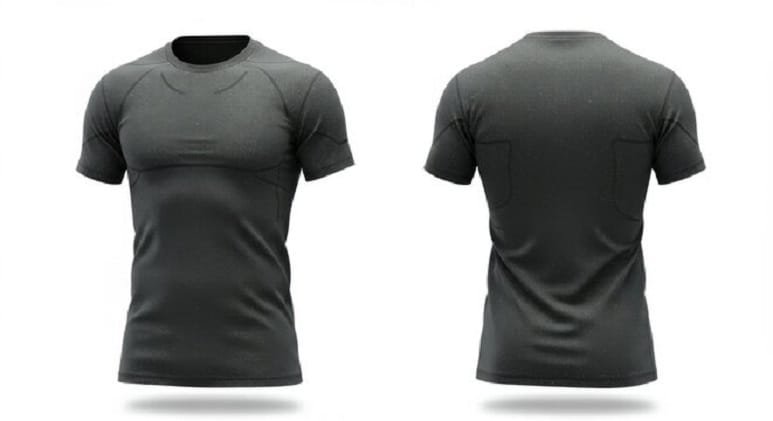Compression Shirt: A Complete Review of Benefits & Top Picks

Compression shirts have become a staple in the wardrobes of athletes, fitness enthusiasts, and individuals seeking enhanced comfort and support during physical activities. These garments are designed to fit snugly against the body, providing various benefits ranging from improved circulation to muscle support. In this comprehensive guide, we’ll delve into the advantages of wearing compression shirts, the materials used, and how to choose the right one for your needs.
What is a Compression Shirt?
Compression shirts are form-fitting garments designed to apply gentle pressure to the muscles, enhancing blood flow and providing support during physical activities. They are commonly worn by athletes, fitness enthusiasts, and individuals seeking muscle support and recovery. These shirts are typically made from elastic materials such as spandex, polyester, or nylon, allowing for a snug yet comfortable fit.
Benefits of Wearing a Compression Shirt
Enhanced Blood Circulation
Compression shirts promote improved blood circulation by applying consistent pressure to the muscles. This enhanced circulation helps deliver oxygen and nutrients more efficiently, reducing muscle fatigue and improving overall performance. Studies have shown that compression garments can aid in reducing muscle soreness and accelerating recovery post-exercise .
Muscle Support and Recovery
The snug fit of compression shirts provides support to the muscles, reducing muscle oscillation and vibration during physical activities. This support helps minimize muscle fatigue and the risk of injury. Additionally, wearing compression shirts post-exercise can aid in muscle recovery by promoting faster removal of lactic acid and other metabolic waste products from the muscles .
Temperature Regulation
Compression shirts are often made from materials that wick moisture away from the body, helping to regulate body temperature during physical activities. These fabrics pull sweat away from the skin, allowing it to evaporate more quickly, keeping the body cool and dry. In cooler conditions, compression shirts can provide an insulating layer that helps retain body heat and keep muscles warm .
Improved Posture
The compression provided by these shirts can also help improve posture. The slight pressure encourages proper alignment of the spine and shoulders, which can be particularly beneficial during strength training exercises or sports that require you to maintain an upright posture .
Moisture-Wicking and Comfort
Modern compression shirts are designed with moisture-wicking fabrics that keep the body dry and comfortable. These materials pull sweat away from the skin, helping to regulate body temperature and prevent chafing. The tight fit also reduces friction, enhancing comfort during prolonged use .
Materials Used in Compression Shirts
Spandex (Lycra/Elastane)
Spandex is a highly elastic fabric that stretches up to five times its original size. This makes it ideal for compression wear, as it can hug the body tightly while allowing full freedom of movement. Spandex’s stretchiness ensures that the shirt maintains its shape over time, even after repeated use .
Polyester
Polyester is a synthetic fabric known for its durability, moisture-wicking properties, and lightweight feel. When blended with other materials like spandex, polyester helps improve breathability and keep the body dry during physical activities. It’s a great option if you need a compression shirt that’s built to last through multiple washes and extended wear .
Nylon
Nylon is another synthetic material commonly used in compression shirts. It’s lightweight, soft to the touch, and breathable, making it comfortable for long periods of wear. Like polyester, nylon is also moisture-wicking, ensuring you stay dry during your workouts .
Choosing the Right Compression Shirt
Consider Your Activity Level
Different compression shirts are designed for various activities. If you’re engaging in high-impact sports, look for shirts that offer maximum muscle support. For endurance activities like running or cycling, opt for shirts that provide optimal breathability and moisture-wicking properties.
Fit and Size (continued)
A compression shirt should fit snugly but not restrictively. It should feel like a second skin—tight enough to provide support but not so tight that it impairs breathing or movement. Sizing charts provided by manufacturers are a great starting point, but always check user reviews for sizing insights. Some brands may run small or large, and choosing the correct size ensures you experience the full range of benefits.
📝 Tip: If you’re between sizes, it’s usually better to size up unless you specifically want a tighter, more restrictive compression fit.
Fabric and Breathability
Breathability is key for maintaining comfort, especially during prolonged or intense workouts. Look for shirts with:
- Mesh panels for ventilation.
- Moisture-wicking fabric to keep you dry.
- Anti-odor technology, which is often infused in high-end compression shirts.
The best compression shirts strike a balance between compression, comfort, and ventilation.
Brand Reputation
Not all compression shirts are created equal. Choose brands known for quality, durability, and real results. Top sports brands have invested in research-backed compression gear that often outperforms generic alternatives.
Trusted brands include:
- Under Armour
- Nike
- 2XU
- Skins
- Adidas
These companies use scientifically backed materials and ergonomic designs proven to enhance performance and recovery.
Top Compression Shirts in the Market
Let’s dive into some of the best-rated compression shirts currently available:
1. Under Armour HeatGear Compression Shirt
- Best For: All-purpose training
- Material: Polyester & Elastane
- Features: 4-way stretch, quick-dry fabric, strategic ventilation
- Pros: Lightweight, breathable, great for layering
- Cons: Sizes may run small
💬 Expert Tip: This is a go-to for gym enthusiasts. The HeatGear tech makes it ideal for hot and humid conditions.
2. Nike Pro Compression Shirt
- Best For: High-intensity workouts
- Material: Polyester & Spandex
- Features: Mesh panels, moisture-wicking fabric
- Pros: Excellent breathability, durable stitching
- Cons: Less compressive than medical-grade alternatives
💬 Expert Tip: Nike’s Dri-FIT fabric is perfect for athletes who sweat a lot and need fast-drying material.
3. Adidas Techfit Compression Shirt
- Best For: Sports & endurance training
- Material: Recycled polyester
- Features: Techfit technology for optimized movement and power
- Pros: Sustainable materials, compression without chafing
- Cons: Limited color options
💬 Expert Tip: Great eco-conscious option with serious performance benefits.
4. 2XU Compression Shirt
- Best For: Recovery & high-performance sports
- Material: High-quality PWX fabric
- Features: Graduated compression, muscle mapping
- Pros: Medical-grade compression, high durability
- Cons: Higher price point
💬 Expert Tip: Widely used by triathletes and endurance athletes for muscle recovery and support.
5. Skins A400 Compression Shirt
- Best For: Long workouts & recovery
- Material: Polyamide & Elastane
- Features: Dynamic gradient compression
- Pros: Perfect fit with body-mapped panels
- Cons: Premium cost
💬 Expert Tip: This is the Ferrari of compression shirts—pricey but elite in function.
Additional Use Cases Beyond Sports
Compression shirts are not limited to athletes. Here are additional scenarios where they offer benefits:
- Post-surgical recovery – Especially for chest or back surgeries.
- Posture correction – Light compression helps maintain proper spinal alignment.
- Weight loss support – Thermal shirts can help with heat retention and increased sweating.
- Everyday wear – Layer them under clothes for posture and back support during long work hours.
Common Myths About Compression Shirts (Busted!)
- Myth: Compression shirts build muscle.
- ✅ Truth: They support muscle activity but don’t replace workouts.
- Myth: Tighter is always better.
- ✅ Truth: Excessive compression can restrict movement and blood flow.
- Myth: Only athletes benefit.
- ✅ Truth: Anyone seeking better posture, circulation, or back support can benefit.
Conclusion
Compression shirts are more than a trend—they are a functional addition to your fitness and lifestyle gear. From muscle support and enhanced circulation to improved posture and moisture management, they deliver real performance benefits.
Whether you’re an elite athlete, a weekend warrior, or someone looking for better daily comfort and recovery, the right compression shirt can make a noticeable difference. Just remember to focus on fit, material, and intended use when choosing one.


